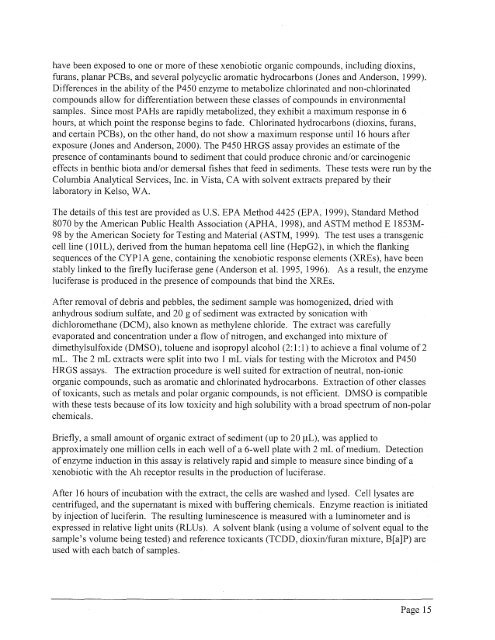Sediment Quality in Puget Sound Year 2 - Center for Coastal ...
Sediment Quality in Puget Sound Year 2 - Center for Coastal ...
Sediment Quality in Puget Sound Year 2 - Center for Coastal ...
Create successful ePaper yourself
Turn your PDF publications into a flip-book with our unique Google optimized e-Paper software.
have been exposed to one or more of these xenobiotic organic compounds, <strong>in</strong>clud<strong>in</strong>g diox<strong>in</strong>s,<br />
furans, planar PCBs, and several polycyclic aromatic hydrocarbons (Jones and Anderson, 1999).<br />
Differences <strong>in</strong> the ability of the P450 enzyme to metabolize chlor<strong>in</strong>ated and non-chlor<strong>in</strong>ated<br />
compounds allow <strong>for</strong> differentiation between these classes of compounds <strong>in</strong> environmental<br />
samples. S<strong>in</strong>ce most PAHs are rapidly metabolized, they exhibit a maximum response <strong>in</strong> 6<br />
hours, at which po<strong>in</strong>t the response beg<strong>in</strong>s to fade. Chlor<strong>in</strong>ated hydrocarbons (diox<strong>in</strong>s, furans,<br />
and certa<strong>in</strong> PCBs), on the other hand, do not show a maximum response until 16 hours after<br />
exposure (Jones and Anderson, 2000). The P450 HRGS assay provides an estimate of the<br />
presence of contam<strong>in</strong>ants bound to sediment that could produce chronic andlor carc<strong>in</strong>ogenic<br />
effects <strong>in</strong> benthic biota and/or demersal fishes that feed <strong>in</strong> sediments. These tests were run by the<br />
Columbia Analytical Services, Inc. <strong>in</strong> Vista, CA with solvent extracts prepared by their<br />
laboratory <strong>in</strong> Kelso, WA.<br />
The details of this test are provided as U.S. EPA Method 4425 (EPA, 1999), Standard Method<br />
8070 by the American Public Health Association (APHA, 1998), and ASTM method E 1853M-<br />
98 by the American Society <strong>for</strong> Test<strong>in</strong>g and Material (ASTM, 1999). The test uses a transgenic<br />
cell l<strong>in</strong>e (1 OIL), derived from the human hepatoma cell l<strong>in</strong>e (HepG2), <strong>in</strong> which the flank<strong>in</strong>g<br />
sequences of the CYP 1A gene, conta<strong>in</strong><strong>in</strong>g the xenobiotic response elements (XREs), have been<br />
stably l<strong>in</strong>ked to the firefly luciferase gene (Anderson et al. 1995, 1996). As a result, the enzyme<br />
luciferase is produced <strong>in</strong> the presence of compounds that b<strong>in</strong>d the XREs.<br />
After removal of debris and pebbles, the sediment sample was homogenized, dried with<br />
anhydrous sodium sulfate, and 20 g of sediment was extracted by sonication with<br />
dichlorometl~ane (DCM), also known as methylene chloride. The extract was carefully<br />
evaporated and concentration under a flow of nitrogen, and exchanged <strong>in</strong>to mixture of<br />
dimetl~ylsulfoxide (DMSO), toluene and isopropyl alcol~ol (2: 1 : 1) to achieve a f<strong>in</strong>al volume of 2<br />
mL. The 2 mL extracts were split <strong>in</strong>to two 1 mL vials <strong>for</strong> test<strong>in</strong>g with the Microtox and P450<br />
HRGS assays. The extraction procedure is well suited <strong>for</strong> extraction of neutral, non-ionic<br />
organic compounds, such as aromatic and chlor<strong>in</strong>ated hydrocarbons. Extraction of other classes<br />
of toxicants, such as metals and polar organic compounds, is not efficient. DMSO is compatible<br />
with these tests because of its low toxicity and high solubility with a broad spectrum of non-polar<br />
chemicals.<br />
Briefly, a small amount of organic extract of sediment (up to 20 pL), was applied to<br />
approximately one million cells <strong>in</strong> each well of a 6-well plate with 2 mL of medium. Detection<br />
of enzyme <strong>in</strong>duction <strong>in</strong> this assay is relatively rapid and simple to measure s<strong>in</strong>ce b<strong>in</strong>d<strong>in</strong>g of a<br />
xenobiotic with the Ah receptor results <strong>in</strong> the production of luciferase.<br />
After 16 hours of <strong>in</strong>cubation with the extract, the cells are washed and lysed. Cell lysates are<br />
centrifuged, and the supernatant is mixed with buffer<strong>in</strong>g chemicals. Enzyme reaction is <strong>in</strong>itiated<br />
by <strong>in</strong>jection of lucifer<strong>in</strong>. The result<strong>in</strong>g lum<strong>in</strong>escence is measured with a lum<strong>in</strong>ometer and is<br />
expressed <strong>in</strong> relative light units (RLUs). A solvent blank (us<strong>in</strong>g a volume of solvent equal to the<br />
sample's volume be<strong>in</strong>g tested) and reference toxicants (TCDD, diox<strong>in</strong>lfuran mixture, B[a]P) are<br />
used with each batch of samples.<br />
Page 15







